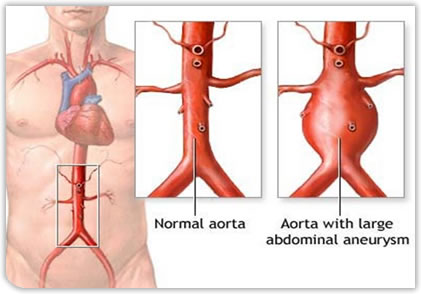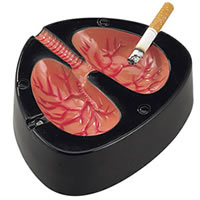Abdominal Aortic Aneurysms Explained
What is an abdominal aneurysm?
An aneurysm is a swelling of an artery. It is caused by a weakening in the wall of an artery. The heart pumps blood under pressure through the arteries to all the places in the body where it is needed. If the wall of the artery becomes weakened, then the pressure will gradually stretch the artery and it will get bigger and continue to enlarge and stretch because of the pressure it is under.
 The aorta is the
main artery that takes blood from the heart and the abdominal aorta is the part
of it in the belly. This is the most common site for aneurysms to develop.
The aorta is the
main artery that takes blood from the heart and the abdominal aorta is the part
of it in the belly. This is the most common site for aneurysms to develop.
Abdominal aortic aneurysms are generally asymptomatic before rupture. That is, they show no specific symptoms and the person is unaware that they have an aneurysm, which is often discovered as a result of investigations for another medical problem.
 Who gets abdominal aortic aneurysms?
Who gets abdominal aortic aneurysms?
Aneurysms occur most commonly in the elderly. By the age of 65, approximately one in 20 men will have an abdominal aortic aneurysm. They are much less common in women and occur in an older age group.
Why do people get aneurysms?
Aneurysms are much commoner in people who smoke and also those in whom a first-degree relative has an aneurysm. A first-degree relative is a direct blood relative, for example, mother, father, brother or sister. They are commoner with increasing age and also in those with high blood pressure and high fat levels in the blood. The net effect of all these factors is to damage the wall of the artery, which then gradually stretches under pressure.
What symptoms can they cause?
Most aneurysms cause no symptoms whatsoever and are discovered accidentally, usually while someone is having a scan for something else.
You may well ask why, if the aneurysm is causing no trouble, is it worth bothering with? The reason for this is that sometimes when large, the aneurysm wall can give way and the artery then bursts (rupture). As can be imagined, when the main artery in the belly bursts, this can cause major internal bleeding and is usually (about 80% of the time) fatal. This causes about 7000 deaths per year in England and Wales. The good news is that fortunately, the majority of aneurysms will never burst. Many people with an aneurysm will eventually die of something else with their aneurysm never having given them any trouble for their entire life. The guiding principle in the treatment and the management of aneurysms is to detect and treat those aneurysms which are likely to burst before they burst, while avoiding unnecessary treatment in aneurysms which would not have caused any trouble if left alone. The key idea is that there is a balance between the risk of leaving the aneurysm untreated and the risk of fixing it.
An aneurysm may remain asymptomatic (showing no outward symptoms)
A big abdominal aortic aneurysm may present as a large, pulsating lump somewhere above the belly button.
Many aneurysms will never cause any symptoms but if they do cause symptoms rupture is usually the first hint of aneurysm. Once an aneurysm has ruptured it causes pain, blood pressure drops dramatically and the fluid accumulation can be felt. An acute pain is usually reported in the abdomen, back or side. It is typically severe and constant, and may seem to spread through the abdomen to the back.
If someone is known to have a large AAA and then starts to develop a new significant back/abdominal pain which persists, then they need urgent medical advice, or if severe dial 999, remember to tell whoever you talk to that they have an AAA. This should be distinguished from the everyday niggles which most of us get when we overdo it!
How can you tell if an aneurysm is likely to burst?
Unfortunately, there is no absolute way to tell if a particular person's aneurysm is likely to burst, but we do know that the larger the aneurysm, the more likely it is to burst. The good news is that small aneurysms are very unlikely to burst and can safely be left alone and kept an eye on. A multi-centre study, the UK Small Aneurysm Study, showed that in men it was safe not to treat aneurysms of less than 5.5 cm in diameter. Most aneurysms are below this size and so for most people once an aneurysm has been discovered, it should be kept an eye on with regular ultrasound scans to see if it is changing in size and then treatment should be considered once it reaches the size of 5.5 cm in diameter or probably 5 cm in women.
When is it right to treat an aneurysm?
The patient their family and the doctor need to consider a number of factors when deciding whether or not an AAA should be treated. These are;
- What is the risk of rupture if it is not treated?
- Life expectancy
- Quality of life
- Attitude to risk
- Risk of treatment
What is the risk of rupture if it is not treated?
The risk increases with increasing size as shown in the table below.
| AAA diameter (cms) | One year risk of rupture | Five year risk of rupture |
|---|---|---|
| 5.5-5.9 | 3.3% | 25% |
| 6.0-7.0 | 9.4% | 35% |
| 7.0-7.9 | 24% | 75% |
Aside from the size of the aneurysm and the likelihood of it rupturing, the other important factor to consider is the person in whom it occurs. There are a number of things to be considered.
Life expectancy
If someone has a very poor life expectancy because of other diseases or very advanced age, then it is not sensible to fix their aneurysm. For example, for a person with incurable cancer, it would clearly make no sense to fix their aneurysm even if it was large; their life expectancy would in any event be very short. Similar arguments apply to other serious medical conditions, for example severe heart disease or lung disease. These both increase the risk of fixing the aneurysm and decrease the benefit since they may reduce life expectancy whether or not the aneurysm is fixed.
Quality of life
Quality of life is also important. If someone has a poor quality of life because of chronic severe pain for example, it may not be appropriate to undertake a procedure which may have the effect of prolonging their suffering.
Attitude to risk:
People's attitude to risk is also important. Some people are very keen to get their aneurysm fixed and to know that the problem has been dealt with. Others are much more fatalistic and take a "what will be, will be" attitude and are prepared to take a chance and avoid the inconvenience of treatment. Some people take the attitude of "at my age I simply do not what to go through the aggravation of an operation and I would rather take my chance." There is no right or wrong answer and it important to discuss this with your surgeon.
Risk of treatment:
If other medical problems, for example heart disease, significantly increase the risk of treating the aneurysm then it may be sensible to wait until the aneurysm is larger before considering treatment, some people would argue that it is safe to leave an aneurysm until it reaches 6.0 cm in size in any event and certainly the higher the risk of treatment the more sense it makes to wait until the aneurysm is a bit bigger before considering fixing it. In some people the risk of fixing the aneurysm may be so high that it would not be sensible to fix it under any circumstances. Obviously it makes sense to do everything possible to get people in as good general condition as possible, both for its own sake and to reduce the risk of treatment.
Is there anything I can do to stop my aneurysm getting bigger?
Smoking: doubles the growth rate of AAA (Smoking and growth rate of small abdominal aortic aneurysms. MacSweeney ST et al. Lancet. 1994) It is very important to stop smoking for this reason and also because it increases the risk of treatment if it becomes necessary.
Blood Pressure: High blood pressure is a risk in it's own right and increases the pressure on the aneurysm wall. It is important that this is well controlled.
Cholesterol Tablets (statins): Cholesterol tablets are good for people with arterial disease and possibly also help to reduce the growth rates of AAA.
Aspirin: People with arterial disease also benefit from being on low dose Aspirin (75mg once a day). For people who cannot take aspirin, clopidogrel is an alternative.
You should discuss this with your GP or specialist.
 Contact Me
Contact Me